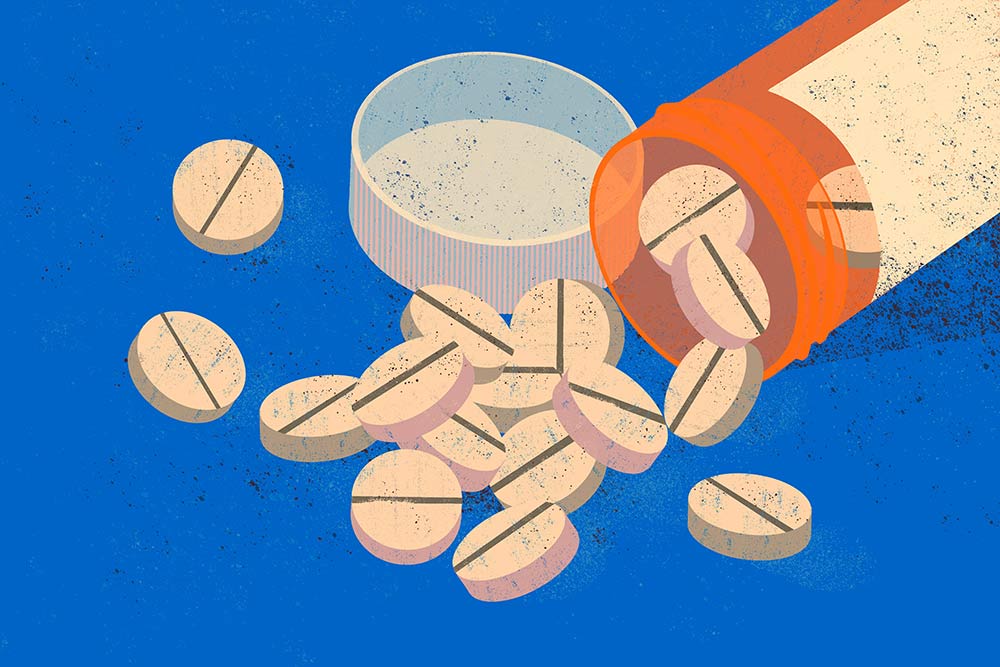The Danger of Opioid Painkillers After Childbirth

While legal when administered by a doctor, opioids pose risks you should consider before filling your prescription.
Medical Expert: Andrew Combs, MD, MFM, PhD
For many new parents, post-birth recovery involves pain medication to help with the first few weeks of healing after delivery. While most postpartum pain is normal, especially after a cesarean (C-section) or a perineal tear, it can cause significant discomfort to a birth parent and hinder the process of adjusting to life with a newborn.
For this reason, your doctor will assess your pain management needs and provide recommended prescriptions and instructions for at-home care. Over-the-counter pain relievers like acetaminophen (Tylenol) and ibuprofen (Motrin, Advil) are often prescribed first because only low levels of each drug are transferred to breast milk, making them safe to take while breastfeeding. Other times, your doctor may prescribe a low dose of a mild opioid to take for a short period.
According to the National Institute on Drug Abuse (NIDA), opioids include prescription medications such as oxycodone, hydrocodone, codeine, and morphine, synthetic opioids such as fentanyl, and the illegal drug heroin. The difference between these types of drugs is how they are produced (whether found in nature or chemically made), the level of concentration in each dose, and how they are administered. But the side effects—and risks—are the same, as all opioids bind to and activate opioid receptors in the brain, spinal cord, and other organs in the body. In addition to relieving pain, NIDA explains that opioids create a relaxing, euphoric feeling for the person using them. This “high” can be dangerous because “opioids can be highly addictive, and overdoses and death are common.”
The Centers for Disease Control and Prevention (CDC) estimates there were approximately 108,000 drug overdose deaths in 2021. Of those deaths, 71,000 were caused by synthetic opioids, and another 13,500 were due to prescription medications. Of course, a doctor likely has the best intentions when prescribing opioid painkillers to a patient—and most patients simply plan to follow their doctor’s orders—but research has shown opioid prescriptions after birth can come with vast consequences.
Research on Postpartum Opioid Use
A 2020 Vanderbilt University Medical Center study published in the Annals of Internal Medicine found that women prescribed opioids after childbirth “have an increased risk of persistent opioid use or other serious opioid-related events, including overdose, in their first year postpartum.” According to the findings, this is true regardless of whether patients had a vaginal or cesarean delivery.
The study followed more than 160,000 women ages 18–44 who had no history of opioid prescriptions or opioid use disorder within 180 days before their delivery. Of those patients, about 50% who delivered vaginally and 91% who delivered via C-section went on to fill at least one prescription of opioid painkillers. Of those patients, approximately 10% of vaginal births and 24% of cesarean deliveries filled a second prescription during the postpartum period.
Another 2019 study from the University of Michigan published in the Journal of the American Medical Association (JAMA) discovered that of the 308,000 deliveries followed, 2.2% of women who had a C-section and 1.7% of women who gave birth vaginally refilled their opioid prescription at least twice and up to a year after childbirth. While these percentages might seem small, it’s important to note that in 2021 alone, there were over 3.5 million registered births in the U.S. compared to the study sample. Additionally, the study only included patients with private health insurance, so the actual rate of opioid misuse after birth for all new mothers (including those on Medicaid or those without health insurance) may be higher.
With both studies pointing to the need for judicious opioid prescribing to help decrease continued drug use after birth, it begs the question of when these prescriptions are actually needed. Perhaps surprisingly, it’s not as often as you would expect.
“After a vaginal delivery, opioids are usually not needed unless there has been major damage to the perineum or rectum. Despite this, some physicians routinely prescribe opioids for vaginal births, too,” explains Andrew Combs, MD, PhD, a maternal-fetal medicine (MFM) specialist and senior adviser for MFM clinical quality at Pediatrix Medical Group in Sunrise, Florida. “This became commonplace during the early 2000s when [doctors] were inundated with the dogma that encouraged us to overprescribe opioids and to be aggressive in our attempts to eradicate all pain. Some of that teaching is still ingrained, and it has taken substantial reeducation for [providers] to learn that opioids are not usually needed in these cases.”
Even regarding cesarean births, Dr. Combs says opioids are not always necessary. Associated pain may even be better treated with nonsteroidal anti-inflammatory drugs (NSAIDs) in combination with acetaminophen when given routinely on a strict schedule. “Two recent studies showed that about 1 in 3 cesarean patients who received a time-scheduled intravenous NSAID needed no opioids postoperatively. This [approach] is far better than waiting for the pain to occur and then trying to reduce it with opioids.”
Despite these findings, Dr. Combs says opioids are overprescribed and that many patients who are given a prescription never need it in the first place.
“Upon discharge from the hospital after a cesarean, many OBs routinely prescribe a fixed number of opioid tablets (often 20, sometimes 80 or more) without regard to whether the patient needed opioids during the last day or so of hospitalization,” he says, adding, “Typical patients actually use fewer than 10 tablets.”
Whether a person uses opioids for a few days, weeks, or longer, unpleasant and risky side effects can occur, including grogginess, dizziness, confusion, nausea, vomiting, constipation, and slowed breathing. In rare cases, suppressed respiration can cause death, though Dr. Combs explains that this would likely result from a patient taking more than the prescribed amount of medication. Additionally, he says opioids are transferred from the birth parent to the baby through breast milk and can “cause somnolence (extreme drowsiness) and feeding difficulties in newborns, and in some cases, respiratory suppression or death.”
Determining if Opioids Are Right For You
If you’re considering using opioids for postpartum pain, know that certain factors can increase your risk of developing a substance use disorder. “Persistent opioid use postpartum is more common in people who reported chronic pain during pregnancy (for example, chronic back pain), in people with depression or other mental health disorders, and in people who use other drugs, such as nicotine, alcohol, marijuana, or cocaine,” says Dr. Combs.
In addition to knowing your risk factors, it’s crucial to have a plan for postpartum pain management before delivery. Start by having a conversation with your provider about any concerns you have surrounding prescription medications. Maintaining an open and honest dialogue with your doctor about opioid use will help keep it routine and front of mind at your prenatal and postpartum visits. Next, Dr. Combs encourages patients to find out if their hospital has an Enhanced Recovery After Surgery (ERAS) program that works to prevent the use of opioids whenever possible. He says birth parents can also talk with the anesthesiologist before surgery about alternative methods to reduce pain during the first 24 hours after a C-section, including neuraxial morphine and a TAP block, to minimize the need for opioids.
Another essential component of postpartum care is asking your partner, family, doula, or friends to help keep up with your dosing schedule and look for potential warning signs, such as filling a second prescription. This is especially pertinent because new parents are incredibly sleep deprived and may struggle to remember when they last took their medication. Instruct your loved ones to routinely ask how you’re feeling and whether or not your pain seems well controlled. Dr. Combs notes that pain “should decrease each day, and patients should be fully functional and fully mobile” while treating pain at home. If you’re ever unsure about the progression of your pain or healing, don’t wait to contact your OB for help.
The choice to use opioid painkillers is between you and your doctor, and in some circumstances, filling the prescription is the right decision. Still, it’s important to fully understand the potential risks long before you deliver your baby to better prepare for a healthy postpartum experience and transition into parenthood.








